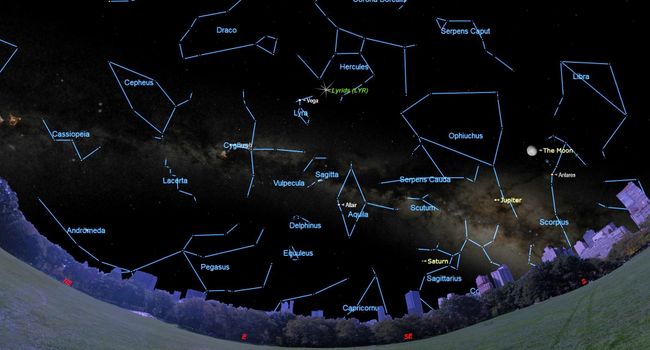Lyrid Meteor Shower 2019 Peaks Overnight Tonight and Monday!
By Sarah Lewin 11 hours ago Skywatching
Look for bright meteors in the early hours.
Look up: It's the Lyrid meteor shower!
Different skywatching organizations have been pinning the meteor shower's peak on different nights as it continues through both April 21-22 and April 22-23. Whichever night you look, here are some tips for viewing the burning-up dust and debris left behind by Comet Thatcher in its trek around the solar system. Skywatchers can expect to see about 18 meteors per hour, though the bright moon may make them difficult to spot, NASA meteor expert Bill Cooke told Space.com.
Meteor showers like the Lyrids occur when Earth passes through the dusty trail left behind by a comet. The meteors can appear all across the sky, but they seem to streak out of a spot to the northeast of the bright star Vega (called the meteor shower's radiant). This meteor shower is easier to see in the Northern Hemisphere because that part of the sky is high above the horizon before dawn, although you can see a lower rate from the Southern Hemisphere.

The annual Lyrid meteor shower, derived from particles dropped by comet C/1861 G1
(Thatcher), runs from April 16 to 28 and peaks on Monday, April 22. The meteors will
streak away from a point in the sky (the shower's radiant) near the bright star Vega,
which will be high in the eastern sky before dawn. The Lyrids can produce up to 18
meteors per hour, with occasional fireballs. Unfortunately, a bright, gibbous moon will
wash out all but the brightest meteors this year.
(Image: © Starry Night software)
People in the Northeast will see the radiant rise around 9 or 10 p.m. in their local time zones, and it will continue to climb in the sky throughout the night — but the moon will also rise soon after, so you could try to spot meteors within that window. (The moon rises earlier the night of April 21 than the night of April 22.) Otherwise, going out closer to 3 or 4 a.m. will put the radiant in the best spot for you to see meteors, although they'll be washed out by the moon.
Regardless of when you look, the key to watching a meteor shower is to go somewhere as dark as possible and make sure you give your eyes enough time to adjust — don't just dart outside to look at one; allow 20-30 minutes to adjust. Be sure to dress warmly, if you're somewhere cold, and get somewhere comfortable to sit where you can lean back and look at the whole sky. Because meteors can appear all across the sky, the naked eye is the best tool you can use; telescopes and binoculars will narrow your view.
More:
https://www.space.com/lyrid-meteor-shower-2019-peaking-now.html?utm_source=notification
